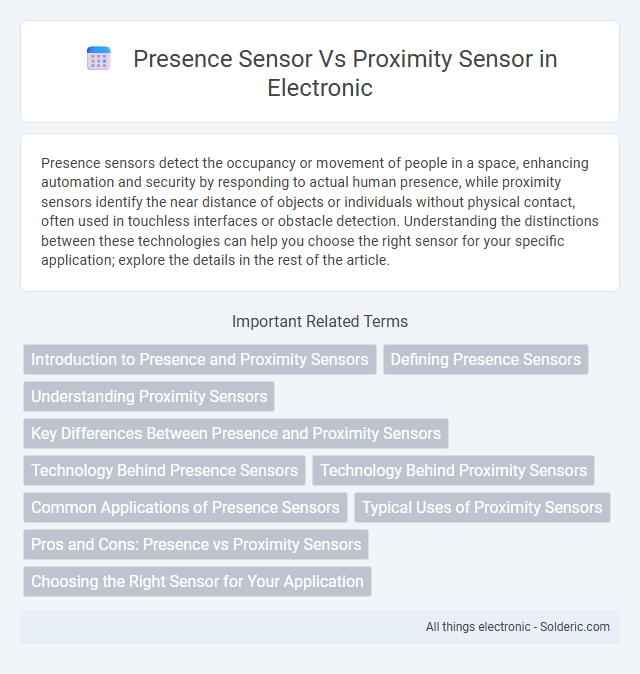Presence sensors detect the occupancy or movement of people in a space, enhancing automation and security by responding to actual human presence, while proximity sensors identify the near distance of objects or individuals without physical contact, often used in touchless interfaces or obstacle detection. Understanding the distinctions between these technologies can help you choose the right sensor for your specific application; explore the details in the rest of the article.
Comparison Table
| Feature | Presence Sensor | Proximity Sensor |
|---|---|---|
| Definition | Detects human presence in an area | Detects object distance without physical contact |
| Common Technologies | Infrared (PIR), Ultrasonic | Capacitive, Inductive, Ultrasonic, Infrared |
| Primary Use | Occupancy detection, lighting control | Object detection, touchless switches |
| Detection Range | Up to 10 meters (typical) | Millimeters to several centimeters |
| Sensitivity | Detects human body heat or movement | Detects object proximity, not heat |
| Applications | Smart homes, security, HVAC systems | Mobile devices, robotics, automation |
Introduction to Presence and Proximity Sensors
Presence sensors detect the actual presence or movement of people or objects within a specified area, using technologies such as infrared, ultrasonic, or microwave signals. Proximity sensors measure the distance between the sensor and an object without physical contact, utilizing capacitive, inductive, or optical methods. Both sensors are integral in automation, security, and smart device applications but serve distinct functions based on detection range and type.
Defining Presence Sensors
Presence sensors detect the actual occupancy of a space by sensing the physical presence of people, often using technologies like infrared or ultrasonic waves. Unlike proximity sensors that only register the approach or closeness of an object, presence sensors provide more accurate data about whether a person is actively within a defined area. Understanding how your presence sensor operates can enhance security and energy efficiency in smart environments.
Understanding Proximity Sensors
Proximity sensors detect the presence or absence of an object within a specific range without physical contact, using technologies like capacitive, inductive, ultrasonic, or infrared sensing. Unlike presence sensors that monitor human occupancy or movement, proximity sensors are designed to identify objects based on distance, enabling applications in industrial automation, mobile devices, and safety systems. Key parameters include sensing range, response time, and sensitivity, which influence the sensor's accuracy and suitability for various environments.
Key Differences Between Presence and Proximity Sensors
Presence sensors detect the actual occupancy or movement within a designated area, using technologies like infrared or ultrasonic waves to sense human presence, while proximity sensors identify the closeness of an object without physical contact, commonly using electromagnetic fields or capacitive sensing. Your application requirements determine the choice: presence sensors are ideal for automatic lighting or security systems that respond to human activity, whereas proximity sensors excel in object detection for industrial automation or mobile devices. Key differences include sensitivity range, detection method, and use case specificity, making it crucial to understand sensor capabilities for optimal integration.
Technology Behind Presence Sensors
Presence sensors utilize infrared or ultrasonic technology to detect the actual occupancy of a space by sensing body heat or sound waves reflected by a person, ensuring accurate monitoring of room usage. Unlike proximity sensors that simply detect an object's approach based on electromagnetic fields or capacitive coupling, presence sensors process detailed environmental data to confirm human presence. Your choice of sensor directly impacts energy efficiency and security systems by providing precise real-time occupancy information.
Technology Behind Proximity Sensors
Proximity sensors operate using electromagnetic fields or emitted electromagnetic radiation to detect the presence of objects without physical contact. Common technologies include inductive sensors for metallic object detection, capacitive sensors for detecting both metallic and non-metallic materials, and ultrasonic sensors that use sound waves to measure distance. These sensors play a critical role in automation, safety systems, and consumer electronics by providing reliable, non-invasive object detection.
Common Applications of Presence Sensors
Presence sensors are widely used in building automation systems to detect human occupancy for optimizing energy consumption by controlling lighting and HVAC systems. In security systems, these sensors trigger alarms and activate surveillance cameras when motion or presence is detected in restricted areas. Industrial automation relies on presence sensors to ensure safety by monitoring operator locations near hazardous machinery, preventing accidents and improving workflow efficiency.
Typical Uses of Proximity Sensors
Proximity sensors are commonly used in industrial automation to detect the presence or absence of objects without physical contact, enabling efficient assembly line operations and robotic guidance. They are essential in smartphones and touchless faucets for detecting user gestures or hand movements, enhancing convenience and hygiene. Your security systems also rely on proximity sensors to trigger alarms or lighting when motion is detected nearby.
Pros and Cons: Presence vs Proximity Sensors
Presence sensors detect human occupancy by sensing motion or infrared signatures, offering high accuracy in controlling lighting and HVAC systems but often at a higher cost and complexity. Proximity sensors detect nearby objects without physical contact, providing quick response times and durability for industrial applications but may lack precision in differentiating between humans and inanimate objects. Your choice depends on whether accurate human detection or general object sensing best suits your environment and budget.
Choosing the Right Sensor for Your Application
Presence sensors detect human occupancy by sensing body heat or movement, ideal for energy-saving lighting and security systems where accurate room usage is critical. Proximity sensors measure the distance to nearby objects without physical contact, suitable for automation in manufacturing or mobile devices where precise object detection is necessary. Evaluating your application's environment and interaction requirements will help determine whether a presence sensor's broad detection or a proximity sensor's specific range measurement better meets Your needs.
presence sensor vs proximity sensor Infographic

 solderic.com
solderic.com